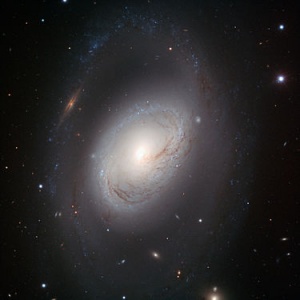Messier 96: Difference between revisions
(Created page with "Messier 96 (also known as M96 or NGC 3368) is an intermediate spiral galaxy about 31 million light-years away in the constellation Leo. It was discovered by French astronomer ...") |
No edit summary |
||
| (4 intermediate revisions by the same user not shown) | |||
| Line 1: | Line 1: | ||
Messier 96 (also known as M96 or NGC 3368) is an intermediate spiral galaxy about 31 million light-years away in the constellation Leo. It was discovered by French astronomer Pierre Méchain on March 20, 1781. After communicating his finding, French astronomer Charles Messier confirmed the finding four days later and added it to his catalogue of nebulous objects. Finding this object is extremely difficult with binoculars. With a telescope of 25.4 cm (10.0 in) aperture, the galaxy is visible as a 3 × 5 arcminute halo with a brighter core region. | [[File:375px-NGC 3368 ESO.jpg|thumb|Messier 96]] | ||
Messier 96 (also known as M96 or NGC 3368) is an intermediate spiral galaxy about 31 million light-years away in the constellation [[Leo]]. It was discovered by French astronomer Pierre Méchain on March 20, 1781. After communicating his finding, French astronomer Charles Messier confirmed the finding four days later and added it to his catalogue of nebulous objects. Finding this object is extremely difficult with binoculars. With a telescope of 25.4 cm (10.0 in) aperture, the galaxy is visible as a 3 × 5 arcminute halo with a brighter core region.This complex galaxy is inclined by an angle of about 53° to the line of sight from the Earth, which is oriented at a position angle of 172°. It is categorized as a double-barred spiral galaxy with a small inner bulge through the core along with an outer bulge. The nucleus displays a weak level of activity of the LINER2 type. Variations in ultraviolet emission from the core suggest the presence of a supermassive black hole. Estimates for the mass of this object range from 1.5×106 to 4.8×107 times the mass of the Sun. On May 9, 1998 a supernova event was observed in this galaxy. | |||
M96 is the brightest galaxy within the M96 Group, a group of galaxies in the constellation Leo that includes the Messier objects M95 and M105, as well as at least nine other galaxies.The M96 galaxy has asymmetric arms and a displaced core, probably caused by the gravitational pull by the other nearby galaxies.<ref>[http://en.wikipedia.org/wiki/Messier_96 Messier 96]</ref> | |||
==HGS Session References== | |||
HGS Sessions - Clearing [[Macau Island, China]] - 3/21/2015 <ref>HGS Session</ref> | |||
==References== | ==References== | ||
| Line 18: | Line 27: | ||
[[Category: HGS Manual]] | [[Category: HGS Manual]] | ||
Latest revision as of 23:42, 21 March 2015
Messier 96 (also known as M96 or NGC 3368) is an intermediate spiral galaxy about 31 million light-years away in the constellation Leo. It was discovered by French astronomer Pierre Méchain on March 20, 1781. After communicating his finding, French astronomer Charles Messier confirmed the finding four days later and added it to his catalogue of nebulous objects. Finding this object is extremely difficult with binoculars. With a telescope of 25.4 cm (10.0 in) aperture, the galaxy is visible as a 3 × 5 arcminute halo with a brighter core region.This complex galaxy is inclined by an angle of about 53° to the line of sight from the Earth, which is oriented at a position angle of 172°. It is categorized as a double-barred spiral galaxy with a small inner bulge through the core along with an outer bulge. The nucleus displays a weak level of activity of the LINER2 type. Variations in ultraviolet emission from the core suggest the presence of a supermassive black hole. Estimates for the mass of this object range from 1.5×106 to 4.8×107 times the mass of the Sun. On May 9, 1998 a supernova event was observed in this galaxy.
M96 is the brightest galaxy within the M96 Group, a group of galaxies in the constellation Leo that includes the Messier objects M95 and M105, as well as at least nine other galaxies.The M96 galaxy has asymmetric arms and a displaced core, probably caused by the gravitational pull by the other nearby galaxies.[1]
HGS Session References
HGS Sessions - Clearing Macau Island, China - 3/21/2015 [2]
References
- ↑ Messier 96
- ↑ HGS Session
Found in HGS Manual on Page 108
Found in HGS Manual on Page 115


